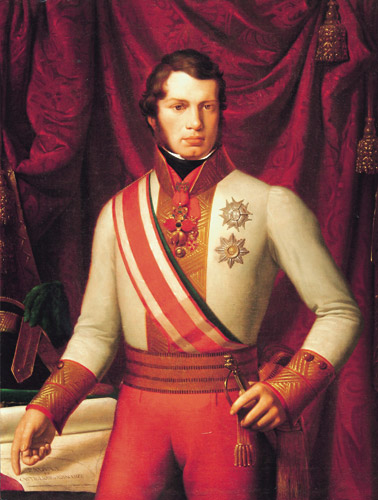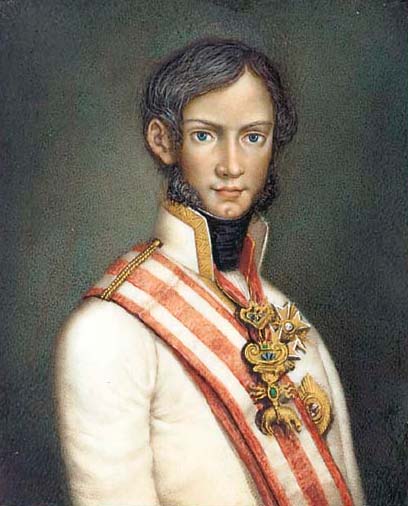<Back to Index>
- Mathematician Pierre René Deligne, 1944
- Poet Sergei Alexandrovich Yesenin, 1895
- Grand Duke of Tuscany Leopold II, 1797
PAGE SPONSOR


Leopold II of Tuscany (Italian: Leopoldo Giovanni Giuseppe Francesco Ferdinando Carlo,German: Leopold Johann Joseph Franz Ferdinand Karl; 3 October 1797 – 29 January 1870) was the last reigning grand duke of Tuscany (1824 – 1859).
He married twice; firstly to Maria Anna of Saxony, and after her death in 1832, to Maria Antonia of the Two - Sicilies. By the latter, he had his eventual successor, Ferdinand.
Leopold was contemporarily recognized as a liberal monarch, authorizing
the Tuscan Constitution of 1848, and allowing a degree of free press. The
Grand Duke was briefly deposed by a provisional government in 1849,
only to be restored the same year with the assistance of Austrian
troops, who occupied the state until 1855. Leopold attempted to pursue
a policy of neutrality in the Second Italian War of Independence,
but found himself expelled by a bloodless coup on April 27, 1859, just
before the beginning of the war. The Grand Ducal family left for
Bologna, in Papal territory. Tuscany was occupied by Victor Emmanuel II of Sardinia for the duration of the conflict. The preliminary peace of Villafranca, agreed to between Napoleon III and Franz Joseph on
July 11, provided for the return of the Lorraines to Florence, but
Leopold himself was seen as too unpopular to be accepted, so on 21 July
1859 he abdicated the throne in favour of his son, Ferdinand. Ferdinand
was not, however, any more acceptable to the revolutionaries in control
at Florence, and his accession was not proclaimed. Instead, the
provisional government proclaimed the deposition of the House of Habsburg - Lorraine (August 16). Born in Florence, Leopold II was the son of Ferdinand III, Grand Duke of Tuscany and Princess Luisa Maria Amelia Teresa of the Two Sicilies, who were double first cousins. His maternal grandparents were Ferdinand I of the Two Sicilies and Marie Caroline of Austria. He
succeeded his father on 18 June 1824. During the first twenty years of
his reign he devoted himself to the internal development of the state.
His was the mildest and least reactionary of all the Italian despots
of the day, and although always subject to Austrian influence he
refused to adopt the Austrian methods of government, allowed a fair
measure of liberty to the press, and permitted many political exiles
from other states to dwell in Tuscany undisturbed. But
when in the early 1840s a feeling of unrest spread throughout Italy,
even in Tuscany demands for a constitution and other political reforms
were advanced; in 1845 and 1846 riots broke out in various parts of the
country, and Leopold granted a number of administrative reforms. But
Austrian influence prevented him from going further, even had he wished
to do so. The election of Pope Pius IX gave
fresh impulse to the Liberal movement, and on 4 September 1847 Leopold
instituted the National Guard - a first step towards the constitution;
shortly after the marchese Cosimo Ridolfi was appointed prime minister.
The granting of the Neapolitan and Piedmontese constitutions was
followed (February 17, 1848) by that of Tuscany, drawn up by Gino Capponi. The uprisings in Milan and in Vienna aroused a fever of patriotic enthusiasm in Tuscany, where war against Austria was
demanded; Leopold, giving way to popular pressure, sent a force of
regulars and volunteers to co-operate with Piedmont in the Lombard
campaign. His speech on their departure was uncompromisingly Italian
and Liberal. "Soldiers," he said, " the holy cause of Italian freedom
is being decided to-day on the fields of Lombardy. Already the citizens
of Milan have purchased their liberty with their blood and with a
heroism of which history offers few examples... Honour to the arms of
Italy! Long live Italian independence!" The Tuscan contingent fought
bravely, though unsuccessfully, at Curtatone and Montanara. On
June 26 the first Tuscan parliament assembled but the disturbances
consequent on the failure of the campaign in Lombardy led to the
resignation of the Ridolfi ministry, which was succeeded by that of
Gino Capponi. The riots continued, especially at Livorno, which was a prey to actual civil war, and the democratic party of which Francesco Domenico Guerrazzi and Giuseppe Montanelli were
leading lights became every day more influential. Capponi resigned, and
Leopold reluctantly agreed to a Montanelli - Guerrazzi ministry, which in
its turn had to fight against the extreme republican party. New
elections in the autumn of 1848 returned a constitutional majority, but
it ended by voting in favour of a constituent assembly. There was talk
of instituting a central Italian kingdom with Leopold as king, to form
part of a larger Italian federation, but in the meanwhile the
grand duke, alarmed at the revolutionary and republican agitations in
Tuscany and encouraged by the success of the Austrian arms, was,
according to Montanelli, negotiating with Field Marshal Radetzky and with Pius IX, who had now abandoned his liberal tendencies, and fled to Gaeta. Leopold had left Florence for Siena, and eventually for Porto Santo Stefano,
leaving a letter to Guerrazzi in which, on account of a protest from
the pope, he declared that he could not agree to the proposed
constituent assembly. The utmost confusion prevailed in Florence and
other parts of Tuscany. On 9 February 1849 the republic was proclaimed, largely as a result of Mazzini's exhortations, and on February 18 Leopold sailed for Gaeta.
A third parliament was elected and Guerrazzi appointed dictator. But
there was great discontent, and the defeat of Charles Albert at Novara
caused consternation among the Liberals. The majority, while fearing an Austrian invasion,
desired the return of the grand duke who had never been unpopular, and
in April 1849 the municipal council usurped the powers of the assembly
and invited him to return, "to save us by means of the restoration of
the constitutional monarchy surrounded by popular institutions, from
the shame and ruin of a foreign invasion." Leopold accepted, although
he said nothing about the foreign invasion, and on 1 May sent Count Luigi Serristori to Tuscany with full powers. But at the same time the Austrians occupied Lucca and Livorno,
and although Leopold simulated surprise at their action it has since
been proved, as the Austrian general d'Aspre declared at the time, that
Austrian intervention was due to the request of the grand duke. On 24
May the latter appointed G Baldasseroni prime minister, on the 25th the
Austrians entered Florence and
on 28 July Leopold himself returned. In April 1850 he concluded a
treaty with Austria sanctioning the continuation for an indefinite
period of the Austrian occupation with 10,000 men; in September he
dismissed parliament, and the following year established a concordat
with the Church of a very clerical character. He feebly asked Austria
if he might maintain the constitution, and the Austrian premier, Prince Schwarzenberg, advised him to consult the pope, the king of Naples and the dukes of Parma and Modena. On
their advice he formally revoked the constitution (1852). Political
trials were held, Guerrazzi and many others being condemned to long
terms of imprisonment, and although in 1855 the Austrian troops left
Tuscany, Leopold's popularity was gone. A part of the Liberals,
however, still believed in the possibility of a constitutional
grand duke who could be induced for a second time to join Piedmont in a
war against Austria, whereas the popular party headed by Ferdinando Bartolommei and Giuseppe Dolfi realized that only by the expulsion of Leopold could the national aspirations be realized. When in 1859 France and Piedmont made war on
Austria, Leopold's government failed to prevent numbers of young Tuscan
volunteers from joining the Franco - Piedmontese forces. Finally an
agreement was arrived at between the aristocratic constitutionalists
and the popular party, as a result of which the grand duke's
participation in the war was formally demanded. Leopold
at first gave way, and entrusted Don Neri Corsini with the formation of
a ministry. The popular demands presented by Corsini were for the
abdication of Leopold in favour of his son, an alliance with Piedmont
and the reorganization of Tuscany in accordance with the eventual and
definite reorganization of Italy. Leopold hesitated and finally
rejected the proposals as derogatory to his dignity. On 27 April there
was great excitement in Florence, Italian colours appeared everywhere,
but order was maintained, and the grand duke and his family departed for Bologna undisturbed.
Thus the revolution was accomplished without a drop of blood being
shed, and after a period of provisional government Tuscany was
incorporated in the kingdom of Italy. On 21 July Leopold abdicated in
favour of his son Ferdinand IV of Tuscany, who never reigned, but issued a protest from Dresden (26 March 1860). Leopold
of Tuscany was a well meaning, not unkindly man, and fonder of his
subjects than were the other Italian despots, but he was weak, and too
closely bound by family ties and Habsburg traditions
ever to become a real Liberal. Had he not joined the conclave of
autocrats at Gaeta, and, above all, had he not summoned Austrian
assistance while denying that he had done so, in 1849, he might yet
have preserved his throne, and even changed the whole course of Italian
history. At the same time his rule, if not harsh, was enervating and
demoralizing. Along with his wife he was the founding patron of L'Istituto Statale della Ss. Annunziata, the first female boarding school in Florence set up to educate aristocratic and noble young ladies. He spent his last years in Austria, and died in Rome. In Dresden on 28 October 1817 by proxy and in Florence on 16 November 1817 in person, Leopold married Princess Maria Anna of Saxony, born in Dresden on 15 November 1799. She was a daughter of Maximilian, Prince of Saxony and Caroline of Bourbon - Parma. Her maternal grandparents were Ferdinand, Duke of Parma and Archduchess Marie Amalie of Austria.
Leopold and his wife were second cousins as they were both
great - grandchildren of Empress Maria Theresa of Austria. They had three
children. Maria Anna died in Pisa on 24 April 1832. On 7 June 1833 in Naples, Leopold married secondly Maria Antonietta of the Two Sicilies (Palermo, 19 December 1814 - Orth, 7 November 1898). His new wife was the second daughter of Francis I of the Two Sicilies and Maria Isabella of Spain. Marie Antoinette was his first cousin. They had ten children.